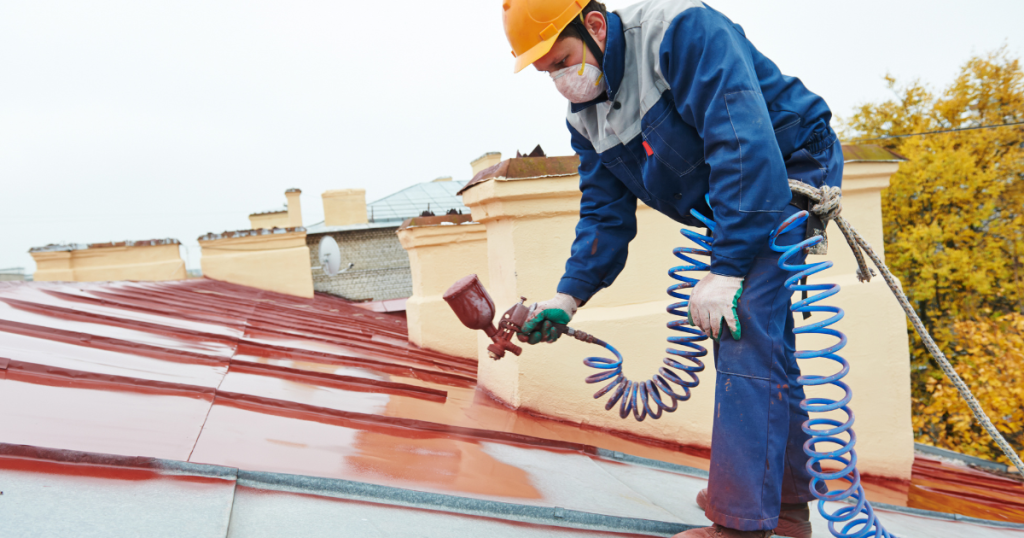Metal roofs have long been praised for their durability and longevity. However, just like any other roofing material, they are not impervious to the damaging effects of water infiltration. Over time, exposure to rain, snow, and moisture can cause metal roofs to rust, corrode, and develop leaks. Fortunately, there is a solution to this problem – waterproofing paint. In this article, we will explore how waterproofing paint can be used on metal roofs to provide an additional layer of protection against water infiltration.

What is Waterproofing Paint?
Waterproofing paint is a specially formulated coating that is designed to repel water and prevent moisture from penetrating the surface it is applied to. It is typically made up of a blend of resins, binders, and additives that create a flexible and protective barrier. This barrier helps to prevent water from seeping through the substrate and causing damage. Waterproofing paint is available in different types, including acrylic, latex, and elastomeric, each offering its unique advantages and applications.
Why is Waterproofing Paint Needed on Metal Roofs?
Metal roofs are prone to water infiltration due to their susceptibility to rust and corrosion. Without proper protection, water can seep through the seams, joints, and tiny imperfections in the metal, gradually damaging the roof structure and compromising its integrity. Waterproofing paint provides a crucial layer of defense against water infiltration, protecting the metal roof from moisture-related issues.
Benefits of Using Waterproofing Paint on Metal Roofs
Using waterproofing paint on metal roofs offers numerous benefits, including:
-
Waterproofing: As the name suggests, the primary benefit of waterproofing paint is its ability to repel water and prevent it from seeping through the metal roof. This prevents leaks and water damage, keeping the interior of your building dry and safe.
-
Corrosion Resistance: Metal roofs are vulnerable to rust and corrosion over time. Waterproofing paint acts as a protective barrier, preventing moisture from coming into contact with the metal surface and inhibiting the corrosion process.
-
Increased Lifespan: By protecting the metal roof from the damaging effects of water, waterproofing paint can extend its lifespan. This means fewer repairs, replacements, and maintenance costs in the long run.
-
Energy Efficiency: Some types of waterproofing paint have reflective properties, helping to reduce heat absorption from the sun. This can improve energy efficiency by keeping the building cooler and reducing the need for excessive air conditioning.
-
Enhanced Aesthetics: Waterproofing paint is available in a variety of colors and finishes, allowing you to customize the look of your metal roof. This can enhance the overall appearance of your building and increase its curb appeal.
How to Apply Waterproofing Paint on Metal Roofs
Applying waterproofing paint on a metal roof requires careful preparation and attention to detail. Here is a step-by-step guide on how to do it correctly:
-
Clean the Surface: Before applying waterproofing paint, it is essential to clean the metal roof thoroughly. Remove any dirt, debris, or loose paint using a pressure washer or scrub brush. Allow the surface to dry completely before proceeding to the next step.
-
Repair Imperfections: Inspect the metal roof for any signs of damage, such as rust spots or holes. Repair these imperfections using appropriate products, such as rust converters or patching materials.
-
Apply Primer: To ensure proper adhesion of the waterproofing paint, apply a primer specifically designed for metal surfaces. Choose a primer that is compatible with the type of waterproofing paint you plan to use.
-
Paint Application: Using a brush, roller, or sprayer, apply the waterproofing paint evenly over the entire metal roof surface. Follow the manufacturer’s instructions regarding the number of coats needed and the drying time between coats.
-
Allow for Curing: After the final coat of waterproofing paint, allow the roof surface to cure as per the manufacturer’s recommendations. This usually takes a few days, so ensure no rain or moisture exposure during this period.
-
Inspect and Maintain: Regularly inspect your metal roof for any signs of damage or wear and tear. Perform necessary maintenance, such as touch-up painting or reapplication of waterproofing paint, to ensure ongoing protection.
Frequently Asked Questions (FAQs)
Q: Can waterproofing paint be applied over an existing metal roof coating?
A: In most cases, waterproofing paint can be applied over an existing metal roof coating. However, it is crucial to patch any damage, clean the surface thoroughly, and ensure compatibility between the existing coating and the new waterproofing paint.
Q: Can waterproofing paint be used on other roofing materials?
A: Yes, waterproofing paint is not limited to just metal roofs. It can also be used on other roofing materials such as concrete, asphalt shingles, or tile roofs to provide an additional layer of protection against water infiltration.
Q: How long does waterproofing paint last on a metal roof?
A: The lifespan of waterproofing paint on a metal roof can vary depending on various factors such as the quality of the paint, climate conditions, and maintenance. Generally, waterproofing paint can last 5-10 years or longer with proper care and maintenance.
Q: Can waterproofing paint be applied by homeowners, or is professional help required?
A: While applying waterproofing paint on a metal roof is possible for homeowners with some DIY experience, it is often recommended to seek professional assistance. Professionals have the expertise and equipment necessary to ensure proper application and maximize the effectiveness of the waterproofing paint.
Conclusion
Waterproofing paint offers an excellent solution for protecting metal roofs from water infiltration. Its waterproofing properties, corrosion resistance, increased lifespan, energy efficiency, and aesthetic enhancements make it an essential component in preserving the integrity of metal roofs. By following the correct application process and regular maintenance, your metal roof can remain durable and resilient for years to come.
